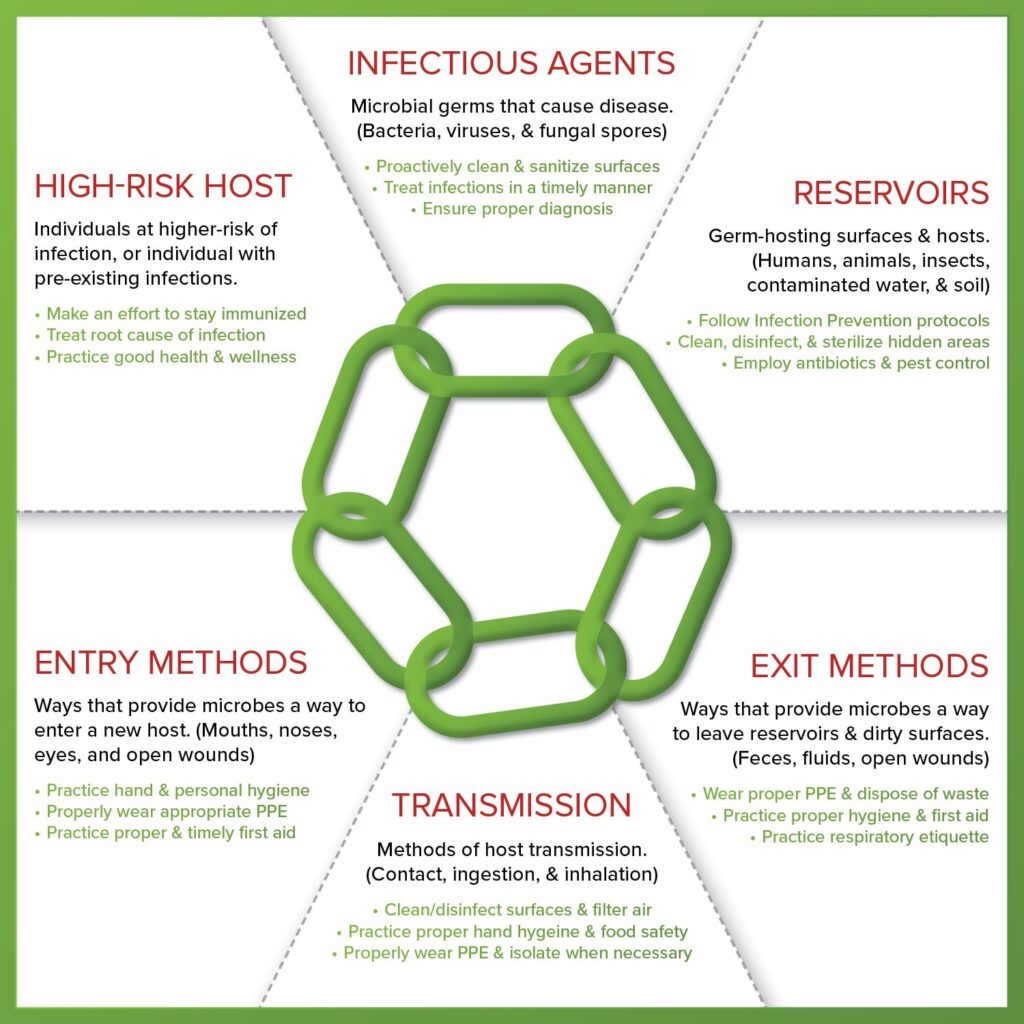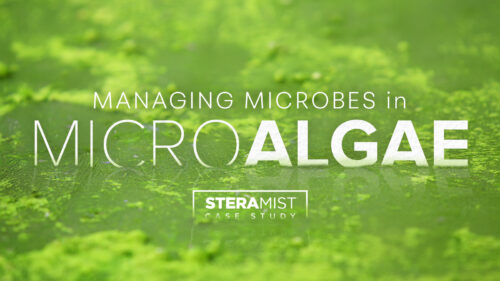Breaking the Chain of Infection
One Process, Six Links in the Chain
Diseases rely on living beings to transfer and thrive from host to host via a wide variety of contamination methods: airborne, contact, liquid, etc. While seemingly unstoppable, the way to stop infection which, is surprisingly simple: No matter the organism, there are six “links” at which the chain of infection can be broken (no matter the organism), and breaking any link goes a long way to ensuring microbial safety. Consider the following vectors:
- Infectious agent: The disease-causing organism (bacteria, virus, parasite, or fungus).
- Reservoir: Where a microbe lives and multiplies. (eg. humans, animals, environments)
- Method of Exit: How a microbe leaves its reservoir. (eg. sneeze, cough, open wound).
- Method of Transmission: How microbes travel from one host to another (airborne, contact, droplet).
- Method of Entry: How microbes enter a new host (eg. mouth, nose, eyes, broken skin).
- Who is Susceptible: Everybody Especially the Susceptible Hosts: Chronically ill, intubated, immunocompromised, or malnourished individuals.
Knowing The Enemy
Accurately identifying the specific organism (or infectious agent) responsible for contaminating spaces is critical in any setting, especially in healthcare. Different microorganisms require distinct cleaning and disinfection protocols to be eliminated effectively, with some more resilient against eradication than others.
Breaking This Link: Target exact microorganisms to eliminate with precision. Choosing the ideal disinfectant, allowing for proper contact time, and employing PPE as needed reduces infection transmission, protects patients and healthcare workers, and improve patient outcomes.
Home is Where the Reservoir Is
A space where an organism lives and multiplies is the reservoir. While environments play host to many microbes, humans and animals are also at risk. Humans are biological beings with their own ecosystem of microbes, offering hospitable temperatures, moisture, and contact with surfaces that provide ideal conditions for microorganisms to grow and reproduce. This also applies to animals, which attract a wider array of zoonotic diseases. Surrounding environments can also host organisms resistant to environmental conditions.
Breaking This Link: Actively clean high-touch and hidden spaces with sufficient cleaning methods, removing potential sources of bacteria (food, soil, biomass, blood, and more) from the area to prevent the spread of microbes via every method of transmission.
Do Unto Others
After becoming established in a reservoir, microbes leave the reservoir to spread to a new host via common methods such as sneezing, coughing, or open wounds. This step is known as the Method of Exit. When an infected individual sneezes or coughs, pathogen-filled droplets are projected into the air where they can be inhaled by others. Exits such as open wounds are also able to spread through direct contact with the wound or other contaminated objects.
Breaking This Link: Be mindful of those around you and stop microbes from releasing into the environment. When coughing or sneezing, use a tissue or the inside of your elbow to prevent airborne and contact transmission. When dealing with an open wound, be sure to clean and cover the wound appropriately and prevent others from coming in contact with either seeping fluid or the wound itself.
A Touchy Subject
Every microbe is transmitted three different ways: Droplets, Airborne, and Direct Contact. When an infected individual coughs or sneezes, the resulting spray and splash droplets carry microbes to a new host. Sometimes, these droplets and other harmful microbes can stay airborne, resulting in transmission when air currents or stagnant air carry microbes. Lastly, dangerous microbes (such as MRSA or VRE) can be passed onto a new host via direct contact when an infected host touches another potential host or surface,
Breaking This Link: Practice good hygiene on yourself and in populated areas. Handle food properly, quickly clean and cover bodily cuts, take at least 20 seconds to wash your hands after touching compromised surfaces, and avoid sharing personal hygiene and items. Also, know your infection vectors, especially within healthcare settings. These vectors include visitors/patients/personnel, dry surfaces (bed rails and medical equipment), and surfaces that could hold biofilm (faucets and toilets).
Any Port in a Storm
The Method of Entry describes how an organism gains access to a new host, and simply put, the same methods of exit are methods of entry: the mouth, nose, eyes, and broken skin. If a microbe can enter an opening via droplet, air, or direct contact, a pathogen, spore, or disease can successfully spread and multiply in a brand-new environment to repeat the cycle of infection.
Breaking This Link: Be cautious and aware of yours and others’ methods of entry. The inhalation of particles, ingestion of contaminated food or water, and contact with infected individuals, animals, and insects are all vehicles that can infiltrate your body and cause havoc with illnesses and disease. Wash/prepare food properly, stay away from others if you or someone else is infected, and keep surfaces as clean as possible.
Caution, Handle with Care
Susceptible Hosts are fragile individuals with a higher degree of infectivity due to various factors, including those receiving healthcare and those with compromised immune systems (such as chemotherapy or transplant patients). Additionally, individuals with invasive medical devices like catheters, breathing tubes, or artificial joints are more prone to infections as these devices can serve as entry points for organisms.
Breaking This Link: Identify and protect these high-risk hosts. Accommodate and provide a clean environment for compromised individuals to prevent the proliferation of healthcare-associated infections and improve patient outcomes.
Surface Disinfection: A Critical Step in Weakened Links
Studies show that, on average, we touch 300 surfaces with the potential to harbor harmful germs every single day, including worktops, door handles, light switches, and so much more. Consistently disinfecting these high-touch areas is crucial for preventing the spread of illnesses like C. difficile, norovirus, and other infections. By prioritizing environmental cleanliness and following recommended cleaning practices, we can significantly reduce the transmission of harmful microorganisms, protect ourselves and others, and contribute to a healthier community.
One disinfection has the ability to weaken every link in the chain of infection. The advanced, broad-spectrum disinfection of SteraMist (among other effective solutions) are critical in the aim to create cleaner environments. From eliminating airborne molecules to sanitizing critical equipment to creating cleaner environments for compromised individuals, SteraMist’s iHP technology easily delivers highly compatible disinfection to any use site.




